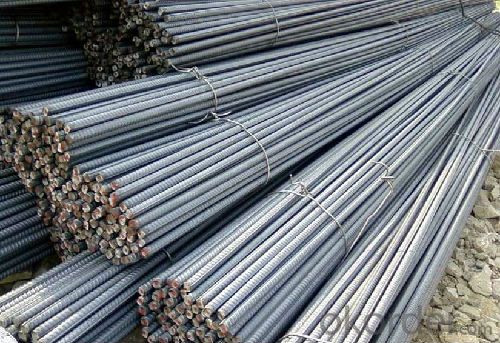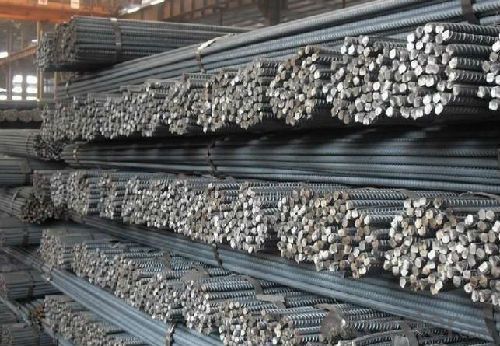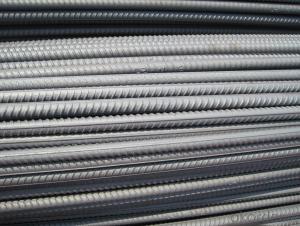High Quality Steel Deformed Bar HRB400 25/28/32mm
- Loading Port:
- Tianjin
- Payment Terms:
- TT or LC
- Min Order Qty:
- 100 m.t
- Supply Capability:
- 10000 m.t/month
OKorder Service Pledge
OKorder Financial Service
You Might Also Like
High Quality Steel Deformed Bar HRB400 25/28/32mm
Product Description:
Specifications of High Quality Steel Deformed Bar HRB400 25/28/32mm:
Standard | GB | HRB400 | |
Diameter | 25mm,28mm,32mm | ||
Length | 6M, 12M | ||
Place of origin | Hebei, China mainland | ||
Advantages | exact size, regular package, chemical and mechanical properties are stable. | ||
Type | Hot rolled deformed steel bar | ||
Chemical Composition of High Quality Steel Deformed Bar HRB400 25/28/32mm: (Please kindly find our chemistry of our material based on HRB400 as below for your information)
Grade | Technical data of the original chemical composition (%) | ||||||
C | Mn | Si | S | P | V | ||
HRB400 | ≤0.25 | ≤1.60 | ≤0.80 | ≤0.045 | ≤0.045 | 0.04-0.12 | |
Physical capability | |||||||
Yield Strength (N/cm²) | Tensile Strength (N/cm²) | Elongation (%) | |||||
≥400 | ≥570 | ≥14 | |||||
Theoretical weight and section area of High Quality Steel Deformed Bar HRB400 25/28/32mm as below for your information:
Diameter(mm) | Section area (mm²) | Mass(kg/m) | Weight of 12m bar(kg) |
25 | 490.9 | 3.85 | 46.2 |
28 | 615.8 | 4.83 | 57.96 |
32 | 804.2 | 6.31 | 75.72 |
Usage and Applications of High Quality Steel Deformed Bar HRB400 25/28/32mm:
Deformed bar is widely used in buildings, bridges, roads and other engineering construction. Big to highways, railways, bridges, culverts, tunnels, public facilities such as flood control, dam, small to housing construction, beam, column, wall and the foundation of the plate, deformed bar is an integral structure material. With the development of world economy and the vigorous development of infrastructure construction, real estate, the demand for deformed bar will be larger and larger.
Packaging & Delivery of High Quality Steel Deformed Bar HRB400 25/28/32mm:
Packaging Detail: products are packed in bundle and then shipped by container or bulk vessel, deformed bar is usually naked strapping delivery, when storing, please pay attention to moisture proof. The performance of rust will produce adverse effect.
Each bundle weight: 2-3MT, or as required
Payment term: TT or L/C
Delivery Detail: within 45 days after received advanced payment or LC.
Label: to be specified by customer, generally, each bundle has 1-2 labels
Trade terms: FOB, CFR, CIF
FAQ:
Q1: Why buy Materials & Equipment from OKorder.com?
A1: All products offered byOKorder.com are carefully selected from China's most reliable manufacturing enterprises. Through its ISO certifications, OKorder.com adheres to the highest standards and a commitment to supply chain safety and customer satisfaction.
Q2: How do we guarantee the quality of our products?
A2: We have established an advanced quality management system which conducts strict quality tests at every step, from raw materials to the final product. At the same time, we provide extensive follow-up service assurances as required.
Q3: How soon can we receive the product after purchase?
A3: Within three days of placing an order, we will arrange production. The shipping date is dependent upon the quatity, how many sizes you want and the plan of production, but is typically 1 month to 2 month days from the beginning of production.
Images of High Quality Steel Deformed Bar HRB400 25/28/32mm:


*If you would like to get our price, please inform us the size, standard/material and quantity. Thank you very much for your attention.
- Q:What are the different grades of epoxy-coated steel rebars?
- The different grades of epoxy-coated steel rebars typically vary based on their mechanical properties, such as tensile strength and yield strength. Some common grades include ASTM A775/A775M-07 Grade 60, ASTM A775/A775M-07 Grade 40, and ASTM A934/A934M Grade 60. These grades are designated based on the specific requirements and standards set by various organizations and regulatory bodies.
- Q:Are there any limitations or restrictions on using steel rebars in construction?
- Steel rebars in construction have certain limitations and restrictions. Here are some of them: 1. Corrosion: Moisture and certain chemical environments can cause steel rebars to corrode, weakening them over time and compromising the structural integrity of the construction. To address this limitation, protective coatings or stainless steel rebars can be employed. 2. Fire Resistance: When exposed to high temperatures during a fire, steel rebars can lose strength and become malleable, leading to potential structural failure. Fireproof coatings or concrete encasement can enhance the fire resistance of steel rebars. 3. Weight: Large-scale construction projects may face challenges in transportation, handling, and installation due to the significant weight of steel rebars. Additional labor or equipment may be necessary, increasing project costs. 4. Thermal Expansion: Steel's high coefficient of thermal expansion causes it to expand and contract significantly with temperature changes. This can result in thermal stresses and concrete cracking around the rebars. Proper design techniques and the use of expansion joints can mitigate this limitation. 5. Electromagnetic Interference: Steel rebars can interfere with electromagnetic signals used in communication systems or sensitive electronic equipment, which is crucial to consider when constructing buildings with specific requirements, such as hospitals or laboratories. 6. Cost: The cost of steel rebars can fluctuate based on market conditions, availability, and quality, impacting the overall budget of construction projects, especially when large quantities are needed. It is important to acknowledge that despite these limitations, steel rebars are widely used in construction due to their strength, durability, and availability. Proper design, construction techniques, and maintenance can help overcome these limitations, ensuring the safe and efficient use of steel rebars in buildings and infrastructure.
- Q:What are the common grades of steel rebars?
- Steel rebars are commonly classified based on their yield strength, which measures the force needed to deform or bend the steel. The most frequently seen grades of steel rebars are Grade 40, Grade 60, and Grade 75. Grade 40 steel rebars possess a minimum yield strength of 40,000 pounds per square inch (psi) and are often utilized in general construction projects that require moderate strength. Grade 60 steel rebars have a minimum yield strength of 60,000 psi and are extensively employed in reinforced concrete structures like bridges, buildings, and highways. They exhibit superior strength and durability compared to Grade 40 rebars, making them suitable for heavy-duty applications. Grade 75 steel rebars have a minimum yield strength of 75,000 psi and are commonly used in high-rise buildings, dams, and other structures that demand exceptional strength and load-bearing capacity. These rebars provide the highest level of strength and are specifically designed for structures exposed to extreme conditions or heavy loads. It should be noted that the selection of the appropriate grade of steel rebars for a specific project is determined by structural engineers, considering factors such as expected loads, environmental conditions, and design specifications.
- Q:What is the maximum length of steel rebars available?
- The specific manufacturer and supplier are the determining factors for the maximum length of steel rebars available. Typically, steel rebars can be found in lengths that range from 6 meters (20 feet) to 18 meters (60 feet). These lengths are established based on various considerations, including transportation logistics, handling capacities, and industry standards within the construction sector. To ascertain the precise maximum length of steel rebars offered, it is crucial to seek guidance from the manufacturer or supplier.
- Q:Can steel rebars be used in hospital construction?
- Yes, steel rebars can be used in hospital construction. Steel rebars are commonly used in reinforced concrete structures, including hospitals, to provide strength and support to the building. They help enhance the structural integrity and ensure the safety and durability of the hospital construction.
- Q:What are the different shapes and profiles of steel rebars?
- Steel rebars are available in various shapes and profiles, including round, square, and deformed. Round rebars have a circular cross-section and are commonly used in general construction projects. Square rebars have a square cross-section and are often used for specific applications that require additional strength and stability. Deformed rebars have ridges or deformations on their surface, which provide enhanced bonding with concrete and are commonly used in reinforced concrete structures to improve load-bearing capacity and prevent slippage.
- Q:How are steel rebars handled and stored on construction sites?
- Construction projects that require reinforced concrete structures rely on steel rebars, which are also known as reinforcing bars. Ensuring the quality and safety of these rebars when handling and storing them on construction sites is of utmost importance. Upon delivery to the construction site, the steel rebars must undergo inspection for any signs of damage or corrosion. If any rebars are found to be damaged, they should be discarded as they can compromise the project's structural integrity. Additionally, the rebars should be checked for proper labeling, including grade, size, and other specifications. Mechanical lifting equipment, such as cranes or forklifts, is typically used to handle steel rebars. It is crucial to use appropriate lifting tools to prevent mishandling or accidents that could result in injuries. The rebars should be lifted vertically to avoid bending or distortion. Once lifted, the steel rebars should be stored in a designated area called a rebar yard. This yard should be clean, well-drained, and organized to prevent potential damage or corrosion. The rebars should be stacked horizontally on leveled ground, ensuring they do not come into direct contact with the soil or water to avoid rusting. To prevent the rebars from rolling or falling, they should be securely tied together using binding wires or steel bands. This practice not only helps maintain the order and stability of the stored rebars but also prevents accidental damage by keeping them away from other construction materials, machinery, or equipment. Proper storage also involves protecting the rebars from adverse weather conditions. Waterproof tarpaulins or plastic sheets should be used to cover the rebars, preventing moisture absorption and corrosion. Adequate ventilation is necessary to avoid moisture accumulation, which can lead to rusting. Regular inspections of the stored rebars are crucial to identify any signs of damage or deterioration. If any rebars are found to be damaged or rusty, they should be promptly removed and replaced to preserve the structural integrity of the construction project. In conclusion, the handling and storage of steel rebars on construction sites require careful attention. Suitable lifting equipment should be used during handling, and a clean and organized rebar yard is necessary for storage. Regular inspections and maintenance are essential to ensure the rebars' quality and prevent any compromise to the construction project's structural integrity.
- Q:How are steel rebars tested for tensile strength?
- Steel rebars are tested for tensile strength by subjecting them to a controlled force in a testing machine. This machine applies an increasing load to the rebar until it fractures. The maximum force applied to the rebar before it breaks is then recorded as the tensile strength.
- Q:What are the guidelines for reinforcing concrete slabs with steel rebars?
- When reinforcing concrete slabs with steel rebars, there are several important factors to consider. Firstly, the required amount of reinforcement must be determined based on the load that the slab will bear. This load can be calculated using structural engineering principles and taking into account factors such as the intended use of the slab, the weight of any equipment or vehicles that will be placed on it, and any applicable building codes or regulations. Once the necessary amount of reinforcement is determined, the next step is to design the layout of the rebars. This involves spacing them at specified intervals to ensure an even distribution of the load across the slab. The spacing will vary depending on the thickness of the slab, with thicker slabs generally requiring more rebars. It is also important to include minimum clearances between the rebars and the edges or bottom of the slab to prevent corrosion and ensure proper concrete cover. The size and type of rebars used is another important consideration. Commonly used types include plain round bars, deformed bars, or welded wire fabric. The diameter of the rebars and the grade of steel should be selected based on the expected load and the requirements of the project specifications or building codes. During the construction process, it is crucial to correctly place and secure the rebars within the formwork to maintain their intended position. This may involve using chairs, spacers, or other devices to ensure proper alignment and prevent displacement. Additionally, care should be taken to avoid damaging the rebars during the pouring and finishing of the concrete. Lastly, it is important to inspect and test the reinforced concrete slab to ensure that the rebars are properly installed and meet the required specifications. This can involve visual inspections, as well as non-destructive testing methods such as ultrasound or ground-penetrating radar to verify the integrity and position of the rebars. In conclusion, adhering to these guidelines for reinforcing concrete slabs with steel rebars will help guarantee the structural integrity and longevity of the slab, while also meeting necessary safety and building code requirements.
- Q:How do steel rebars affect the overall cost of maintenance?
- Steel rebars can significantly affect the overall cost of maintenance in several ways. Firstly, the quality and durability of steel rebars play a crucial role in ensuring the structural integrity of buildings and infrastructure. When steel rebars are of high quality and properly installed, they can enhance the strength and longevity of concrete structures, reducing the need for frequent repairs or replacements. This, in turn, lowers the maintenance costs over time. Additionally, steel rebars provide reinforcement to concrete, making structures more resistant to external forces such as seismic activities, heavy loads, and environmental factors like corrosion. By increasing the structural resilience, steel rebars can minimize the likelihood of damage and the subsequent maintenance expenses that would be required to fix or restore the affected areas. Moreover, proper maintenance of steel rebars themselves is essential to prevent corrosion. Without adequate preventive measures like regular inspections, cleaning, and applying protective coatings, rebars can succumb to rust and corrosion, ultimately compromising the structural integrity of the entire concrete structure. Corrosion-related repairs or replacements can be extremely costly and time-consuming, significantly impacting the overall maintenance budget. Lastly, the choice of steel rebars during the construction or renovation phase can also influence maintenance costs. Opting for higher-grade rebars with superior corrosion resistance can initially increase the upfront costs but can substantially reduce the long-term maintenance expenses. Investing in high-quality steel rebars can minimize the need for frequent repairs and replacements, resulting in overall cost savings and improved structural reliability. In conclusion, steel rebars have a direct impact on the overall cost of maintenance. By providing reinforcement and enhancing structural integrity, high-quality rebars can reduce the need for repairs, prevent damage, and improve the durability of concrete structures. However, neglecting proper maintenance of rebars can lead to corrosion issues, which can be expensive to address. Therefore, careful consideration of the quality, installation, and ongoing maintenance of steel rebars is essential to minimize maintenance costs in the long run.
1. Manufacturer Overview |
|
|---|---|
| Location | |
| Year Established | |
| Annual Output Value | |
| Main Markets | |
| Company Certifications | |
2. Manufacturer Certificates |
|
|---|---|
| a) Certification Name | |
| Range | |
| Reference | |
| Validity Period | |
3. Manufacturer Capability |
|
|---|---|
| a)Trade Capacity | |
| Nearest Port | |
| Export Percentage | |
| No.of Employees in Trade Department | |
| Language Spoken: | |
| b)Factory Information | |
| Factory Size: | |
| No. of Production Lines | |
| Contract Manufacturing | |
| Product Price Range | |
Send your message to us
High Quality Steel Deformed Bar HRB400 25/28/32mm
- Loading Port:
- Tianjin
- Payment Terms:
- TT or LC
- Min Order Qty:
- 100 m.t
- Supply Capability:
- 10000 m.t/month
OKorder Service Pledge
OKorder Financial Service
Similar products
New products
Hot products
Hot Searches
Related keywords




























